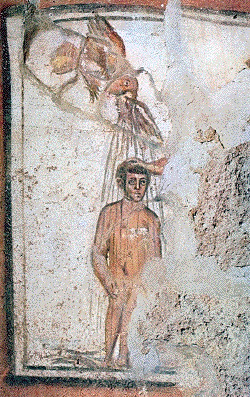Christian symbolism

Christian symbolism gives objects or actions a meaning that shows Christian ideas. Religious symbolism has an effect when it affects both the intellect and the emotions. The choice of actions and objects for symbolism is very small. This makes it hard to chose a symbol that other religions and traditions do not use.[1][2]
Early Christian symbols
[change | change source]Elemental symbols
[change | change source]Elemental symbols were often used by the early Church. Water is an important symbol to Christians. Water is symbolic in baptism. It may also mean cleansing or purity. Fire symbolizes both the Holy Spirit and light. It is often used in the form of a candle flame. The sources of these symbols comes from the Bible. Examples include the tongues of fire that symbolized the Holy Spirit at Pentecost, Jesus' description of his followers as the light of the world, and God is a consuming fire found in Hebrews 12.[3]
Ichthys
[change | change source]The fish was the most important symbol to early Christians. The symbolic fish was familiar to Christians from the earliest times. It can be seen in Roman monuments such as the Capella Greca and the Sacrament Chapels of the catacomb of St Callistus. The fish was used as a Christian symbol in the first decades of the 2nd century.[4] The symbol may come from the miracle Jesus is said to have performed by multiplying loaves of bread and fishes on the shore of the Sea of Galilee.[5] Its popularity is thought to mainly come from an acrostic made of the first letters of five Greek words Iesous CHristos THeou Yios Soter. These form the Greek word Ichthys which means fish. Iesous Christos Theou Yios Soter translates as Jesus Christ, Son of God, Saviour.[4]
Cross and crucifix
[change | change source]
The cross is one of the most well known symbols in the world. It was used as a symbol from the earliest times. This is shown in arguments against Christianity shown in the Octavius of Minucius Felix[6][7]
In the early 3rd century, Clement of Alexandria, used the phrase τὸ κυριακὸν σημεῖον (the Lord's sign) to mean the cross. He used the phrase when discussing that the number 318 (in Greek numerals, ΤΙΗ) in Genesis 14:14 was a foreshadowing of the cross and Jesus. T is the Greek number fore 300. ΙΗ, the first two letters of Jesus's name ΙΗΣΟΥΣ, means 18.[8] Tertullian called the Christian believers crucis religiosi, i.e. "devotees of the Cross".[9] In his book De Corona, Tertullian tells how it was a tradition for Christians to trace the sign of the cross on their foreheads.[10]
The crucifix was not used until the 5th century.[3] French Medievalist historian M.-M. Davy has described in great details Romanesque Symbolism as it developed in the Middle Ages in Western Europe.[11]
Peacock
[change | change source]Ancient people believed that the flesh of a peafowl did not decay after death. It became a symbol of immortality. This symbolism was used by early Christianity. Many early Christian paintings and mosaics show the peacock. The peacock is still used in the Easter season in the east.[12]
Symbols of Christian Churches
[change | change source]
Sacraments
[change | change source]Some of the oldest symbols in the Christian church are the sacraments. The number of sacraments is different in each denominations. All denominations have Eucharist and baptism. Others which may or may not be used are ordination, unction, confirmation, penance and marriage. The rites are seen as a symbol of the spiritual change or event that takes place. In the Eucharist, the bread and wine are symbolic of the body and blood of Jesus. In Roman Catholicism, they become the actual Body of Christ and Blood of Christ through Transubstantiation. This represent salvation brought by the death of Jesus. The rite of baptism is symbolic of the cleansing of the sinner by God. Where baptism is by immersion, it symbolizes spiritual death and resurrection. Different groups believe the sacraments mean different things. Some Protestant denominations think they are only symbolic. Roman Catholics, Orthodox, some Anglicans, and some Lutherans feel that, by the power of God, the sacraments have an actual effect."[13]
Examples of other symbols
[change | change source]
- Alpha and omega
- Anchor
- Apple
- Bestiaries
- Borromean rings
- Burning Bush
- Candles
- Christian flag
- Chi Rho and Labarum
- Cross and Crown
- IHS (monogram)
- Flaming sword
- Ichthys
- INRI
- Lamb
- Mitre
- Pentagram
- Pelican
- Rose Cross
- Shield of the Trinity (or Scutum Fidei)
- Star of David
- Trefoil
- Triquetra
- Vesica Piscis
Related pages
[change | change source]References
[change | change source]- ↑ "Content Pages of the Encyclopedia of Religion and Social Science". Retrieved 2008-10-31.
- ↑ Thurston, Herbert (1912). "Symbolism". Catholic Encyclopedia. Robert Appleton Company. Retrieved 2007-11-26.
- ↑ 3.0 3.1 Dilasser, Maurice. The Symbols of the Church (1999). Collegeville, MN: Liturgical Press, hardcover: ISBN 0-8146-2538-X
- ↑ 4.0 4.1 Hassett, Maurice (1912). "Symbolism of the Fish". Catholic Encyclopedia. Robert Appleton Company. Retrieved 2007-11-26.
- ↑ John 21:9
- ↑ ANF04. Fathers of the Third Century: Tertullian, Part Fourth; Minucius Felix; Commodian; Origen, Parts First and Second | Christian Classics Ethereal Library
- ↑ Minucius Felix speaks of the cross of Jesus in its familiar form, likening it to objects with a crossbeam or to a man with arms outstretched in prayer (Octavius of Minucius Felix, chapter XXIX).
- ↑ Stromata, book VI, chapter XI
- ↑ Apology., chapter xvi. In this chapter and elsewhere in the same book, Tertullian clearly distinguishes between a cross and a stake.
- ↑ "At every forward step and movement, at every going in and out, when we put on our clothes and shoes, when we bathe, when we sit at table, when we light the lamps, on couch, on seat, in all the ordinary actions of daily life, we trace upon the forehead the sign" (De Corona, chapter 3)
- ↑ M.-M. Davy, Initiation à la Symbolique Romane. New edition. Paris: Flammarion, 1977.
- ↑ "Birds, symbolic." Peter and Linda Murray, Oxford Dictionary of Christian Art (2004).
- ↑ Kennedy, D.J (1912). "Sacraments". Catholic Encyclopedia. Robert Appleton Company. Retrieved 2007-11-26.
Other websites
[change | change source]- Symbols in Christian Art and Architecture Comprehensive general listing.
- Christian Symbols Net Very comprehensive site, complete with search engine.
- Christian Symbols and Glossary (keyword searchable, includes symbols of saints)
- ReligionFacts.com: Christian Symbols Basic Christian symbols A to T, types of crosses, number symbolism and color symbolism.
- Meaning of Colors for Flags Biblical meanings of color used for Christian worship flags.
- Color Symbolism in The Bible An in depth study on symbolic color occurrence in The Bible.
- Christian Symbol Wood Carvings Archived 2005-10-26 at the Wayback Machine Forty symbols at Kansas Wesleyan University
- Old Christian Symbols from book by Rudolf Koch
- Christian Symbols, Origins and Meanings Archived 2005-10-22 at the Wayback Machine
- Tree of Jesse Directory by Malcolm Low. Archived 2008-10-12 at the Wayback Machine
- Chrismon Templates Archived 2015-08-13 at the Wayback Machine Symbol outlines that can be use to create Christian themed projects

